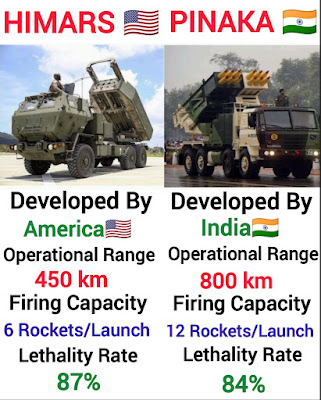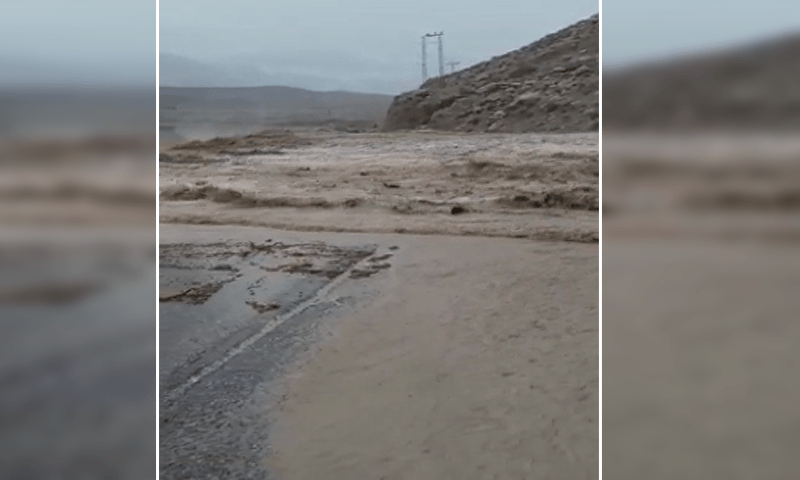HIMARS versus Pinaka: A Comparison
The War in Ukraine has brought into focus long range artillery rocket systems which can cause heavy destruction to the enemy interdicting targets in depth. The United States supply of HIMARS to Ukraine employed effectively has led to a comparison with systems available to the Indian Army - the Pinaka
HIMARS
HIMARS has become a popular name for the military analysts following the war in Ukraine. HIMARS stands for High Mobility Artillery Rocket Systems 16 of which have been provided to Ukraine by the United States. The system is known as M142 High Mobility Artillery Rocket Systems, or HIMARS.
As per Popular mechanics, the HIMARS consists of a medium-sized tactical truck that can carry up to six 227-millimeter GPS-guided rockets and launch them a distance in excess of 43 miles [69 kms].
The rocket is known as the Guided Multiple Launch Rocket System (GMLRS), of thirteen-foot length.
The high explosive content of the rocket is said to be 200-pound and also has 160,000 preformed tungsten fragments with GPS guidance the circular error of probability is 6 feet.
The lethality of the warhead is thus devastating.
The GMLRS platform is mounted on a truck which has what is classically known as, “shoot and scoot,” capability to avoid counter battery fire.
Given the large firing foot print of the HIMARS, detection by counter battery radars is quick and thus targeting by opposing artillery will also come in real time.
However, the mobility of the HIMARS implies that the trucks leave the position even before the rockets reach the target and thus even if detected the counter battery fire is not likely to be effected. As per Popular Mechanics while operating in Ukraine, Russia has not been able to destroy any of the HIMARS platforms so far.
Ukraine has very effectively employed unguided rockets as GRAD to effect as deception while security of the position is very strictly maintained thus identifying these based on the local landmarks is difficult.
The HIMARS also has counter-unmanned aerial systems (C-UAS) to detect and jam drones as per Popular Mechanics.
The manufacturer Lockheed Martin considers HIMARS as a strategic capability, with commonality with M270A1 launch system and MLRS interoperability and is seen as a Long-Range Precision Fires (LRPF) asset.
With the tactical missile the range of the HIMARS is 15 to 499+ km to include the Extended-Range Guided MLRS (ER GMLRS), GMLRS, the Precision Strike Missile (PrSM) and the Army Tactical Missile System (ATACMS) as per Lockheed Martin.
Pinaka
Reports of the South Caucasian country, Armenia importing Pinaka rocket system has brought this in the public eye in India.
The Pinaka rocket system has been developed by Armament Research and Development Establishment, Pune supported by High Energy Materials Research Laboratory, another Pune-based laboratory of DRDO.
Pinaka Mk-1 is a free-flight artillery rocket system of 38 kilometers range, quick reaction time, and a high rate of fire.
The System can fire a salvo of 12 rockets from a multi-barrel launcher in 44 seconds, while a battery can fire 72 rockets.
The 214mm bore Pinaka rocket has a payload of 100 kilograms of varied types from anti-tank mines and blast-cum-pre-fragmented high explosives.
A battery can thus deliver 7.2 tons of payload to a range of 38 kilometers and neutralize a target area of 1000 meters by 800 meters.
On the other hand enhanced Pinaka rockets have a range of over 45 kilometres. The state-owned Munitions India Limited and Nagpur-based Economic Explosives Limited (EEL) met all user requirements during the trials.
In a demonstration to the media, in October last year it was revealed that Indian Army has deployed the Pinaka on the India China border in Eastern sector. At higher altitudes the range can be extended beyond 38 kms which is at the mean sea level.
The artillery battery commander, Lieutenant Colonel Sarath was quoted by the ANI as stating, “The quick reaction time and the high accuracy of these weapon systems ensure delivery of a very high volume of firepower on critical and time-sensitive enemy targets in a very short time.”
The Russian made Smerch on the other hand has a longer range of 90 Km and a battery of four launchers can fire a salvo of 48 rockets in 40 seconds neutralising an area of 1200m by 1200m.
The availability of rocket ammunition for SMERCH is however limited particularly after extensive employment of the same by Russia in the War in Ukraine.
Enhanced Range Pinaka
The Pinaka Mk-I (Enhanced) Rocket System (EPRS) and Pinaka Area Denial Munition (ADM) rocket systems were recently tested by the Defence Research and Development Organisation (DRDO) and Indian Army at Pokhran Firing Ranges in April this year.
24 EPRS rockets were fired for different ranges during the last fortnight.
The EPRS is the upgraded version of Pinaka variant which has been in service with the Indian Army for the last decade.
The system has been upgraded with advanced technologies enhancing the range to meet the emerging requirements.
After establishing the performance efficacy of the enhanced range version of Pinaka, the technology was transferred to the industries viz. Munitions India Limited (MIL) and Economic Explosives Limited Nagpur. Rockets manufactured by MIL under Transfer of Technology from DRDO were flight tested during this campaign.
Different variants of munitions and fuzes which can be used in the Pinaka rocket system were also successfully test evaluated in the Pokhran Field Firing Range.
Comparative Estimates – HIMARS versus Pinaka
HIMARS and Pinaka can be classified as general purpose artillery for neutralization and destruction of large soft targets in the depth of the enemy areas in the form of battlefield interdiction.
A brief comparison will reveal that HIMARS has a longer range than the Pinaka with the one’s that have been provided to Ukraine said to be of 80 kms as against 38 kms of the latter and the possible 45 kms of the extended range which is yet to be introduced in service.
Pinaka Mark 1 is a free flight rocket of caliber 214 mm as opposed to the guided HIMARS of 227 mm. This will imply higher accuracy for the HIMARS.
However DRDO has already developed guidance kit for Pinaka Mk-II rocket for accuracy improvement was taken up by ARDE in association with RCI, DRDL, HEMRL and PXE.
Pinaka caries a warhead of 100 kg as opposed to the 90 kgs warhead of the HIMARS. HIMARS on the other hand also has tungsten fragments with higher lethality.
The mobility for both systems may be at par thus escape ability of counter battery fire is effective.
From the cost point of view the Pinaka Mark 1 though of a shorter range and lesser accuracy will enjoy the advantage over the HIMARS.



Comments
Post a Comment